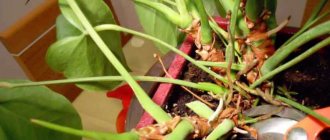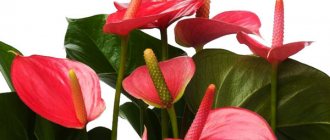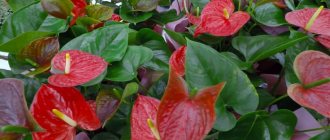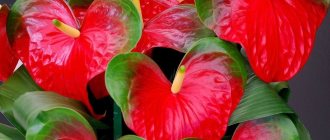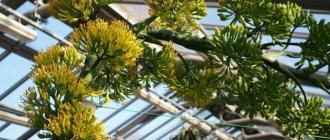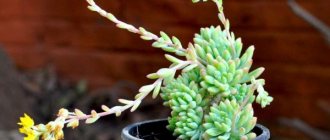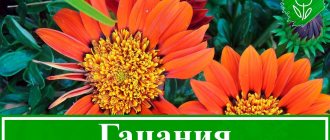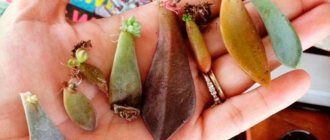Author: Elena N. https://floristics.info/ru/index.php?option=com_contact&view=contact&id=19 Category: Houseplants Published: May 13, 2014Last edits: January 11, 2021
- Anthurium Andraeanum
Botanical description
Anthurium (lat. Anthurium) is a genus of predominantly epiphytic plants from the family of Aroid plants. There are also herbaceous plants, lianas and semi-epiphytes - depending on the species. In nature, anthuriums mainly grow on the North and South American continents in tropical and subtropical zones. Anthurium (Greek “anthos” - flower and “oura” - tail) received its name because of the structure of the flower, which is expressed as a spadix with a leaf-spread. Flowers come in blue, white, red and other colors. Anthurium leaves are leathery, can be whole or dissected, small or large, plain or with a pattern - all this depends on the type and variety of anthurium. Anthurium is one of the most popular members of the family. They grow not only indoor anthurium, but also garden anthurium, and also especially for cutting. Over 100 hybrids are grown in culture, which are planted in gardens, apartments or used in making bouquets. Homemade anthurium is grown both for its beautiful leaves and flowers.
Plant names
In indoor plant growing, anthurium is called “male happiness.” It is believed that if an unmarried woman gets such a flower, she will soon meet her betrothed. There is also an opinion that anthurium can help men with sexual problems.
Another name for the flower is “family happiness.” In families where anthurium appears, mutual understanding and harmony will reign. You can pair it with a plant called “female happiness,” spathiphyllum.
Briefly about cultivation
- Flowering: from February to November.
- Lighting: bright diffused light with protection from direct sunlight.
- Temperature: in spring and summer - 22-28 ºC, from September to February - about 16 ºC, and Scherzer anthurium is kept in winter at 12-14 ºC.
- Watering: during the growing season - abundantly, as soon as the substrate in the pot dries to the middle of the depth. The rest of the time, watering is reduced to moderate.
- Air humidity: high – about 90%. It is recommended to regularly wash the leaves with a damp sponge, spray and keep the plant on a tray with wet pebbles or expanded clay.
- Feeding: in spring and summer, every two to three weeks with complex mineral fertilizer in half the dosage recommended by the manufacturers. Once every one and a half to two weeks, fertilize the leaves.
- Dormant period: from mid-autumn to early spring.
- Transplantation: in February-March, and in case of emergency, from March to August. Young plants are replanted annually, and mature ones - no more than once every 2-3 years.
- Substrate: loose, breathable: 1 part turf soil, 2 parts peat and 2 parts chopped sphagnum.
- Reproduction: seeds and cuttings.
- Pests: aphids, scale insects and spider mites.
- Diseases: the plant can get sick from waterlogging of the soil, lack or excess of nutrients in the substrate, improper care and violation of maintenance conditions.
- Properties: anthurium is poisonous!
Read more about growing anthurium below.
Problems
The plant is very unpretentious, however, it also has a number of problems that can arise due to improper care. These problems can be identified through a routine visual inspection of the plant. If you take timely measures, then, given the good survival rate of the plant, serious problems can be avoided.
The reason for yellowing of anthurium leaves is, most often, the lack of the required amount of light and heat. Move the flower to a south window, place it closer to the light source, turn on the phytolamps for a longer time - and the problem should go away.
If the leaves begin to dry, then this, on the contrary, may be the cause of an excess of light or sunburn. Sometimes the cause of leaf drying is mites or aphids.
Sunburn
Like all members of the araceae family, anthurium is poisonous because it contains calcium oxolate. Its concentration is not as high as, for example, in
zamioculcas
, however, it is enough to cause discomfort to the owner.
Therefore, all operations with the plant must be carried out while observing certain precautions. When trimming leaves, stems and roots of a plant, you must use thin rubber gloves. It is advisable to dispose of gloves after use.
Anthurium is not dangerous for domestic animals, including birds.
Anthurium care at home
Lighting
The anthurium plant feels best on windows on the east or west side, since for normal growth the plant needs bright but diffused light. The plant will grow on northern windows, but there may still be little light. On the south side, the anthurium should be placed away from the window, or the glass should be covered with newspaper (tulle, etc.) so that direct rays do not fall on the leaves during hot hours.
Temperature
Anthurium is a fairly heat-loving plant, so in spring and summer the temperature for it should be in the range from 22 to 28 °C; a drop below 18 °C can lead to the appearance of diseases. From September to February inclusive, the temperature is maintained at about 16 °C, and Scherzer's anthurium needs to be lowered to 12-14 °C for a couple of months. The increase and decrease in temperature during transition periods should be smooth. Anthurium does not like sudden changes in temperature and drafts.
Watering anthurium
Water the anthurium abundantly during the growing season, immediately after the soil dries to half the height of the pot. Water for irrigation should be settled and soft; rainwater is best suited. When watering anthurium, you need to use the rule “it is better to underwater than to overwater,” since the roots of anthurium very quickly begin to rot if the substrate is constantly waterlogged. Excess water from the pan must be drained immediately after watering.
- Fact 5 – Violet is a sacred flower
Spraying
The anthurium flower requires high air humidity (about 90%), since insufficient humidity causes the plant to slow down its development. Anthurium leaves should be wiped with a damp soft sponge from time to time to remove dust. In warm weather, the leaves also need to be sprayed (with warm, settled water), which also has a positive effect on the growth of the plant, and the pot itself, to increase the humidity around it, it is advisable to place it on a tray with wet pebbles or expanded clay, but so that the pot is not immersed in water. Only the leaves need to be sprayed, since water getting on the flowers can cause stains to appear on them and reduce the decorative qualities of the anthurium.
Top dressing
The plant needs regular feeding, but you need to remember that mineral fertilizers need to be diluted twice as much as the standard recommended dose. Fertilizers are applied only in spring and summer every 15-20 days. You can feed the anthurium using foliar feeding - this is done more often, every week and a half. Applying organic fertilizers will be very useful, but it is not always convenient to apply them indoors. An infusion of chicken droppings or fermented mullein, as well as leaf humus, cow or half-rotted horse manure, are suitable.
Bloom
To stimulate good budding and subsequent flowering, the anthurium needs to be provided with a cool winter for one and a half to two months (14-16 °C). If proper care is taken, flowering can continue from late spring to early autumn, and some Andre anthurium hybrids can bloom almost all year round. In order for a flower to bloom better, you need to cut off the faded inflorescences, which will save the plant strength for young flowers. If you want to get seeds, then the flowers need to be artificially pollinated by transferring pollen from one flower to another using a soft brush. If you cut off well-formed flowers, they can last in a vase from 20 to 35 days, and not fully formed cobs fade very quickly - they won’t last even 5 days.
Anthurium transplant
Anthurium is replanted at the beginning of active growth (February-March) or from March to August, if necessary, and this is done carefully, since the roots and leaves are very easy to damage. Young specimens are replanted annually, with the pot increasing in diameter by 1-2 cm each time. Adult plants are replanted as needed (if the pot has become small), but usually no more than once every two to three years. A plastic pot is used for planting, since in a ceramic one the soil temperature is usually slightly lower than the air temperature. The pot is taken as wide as it is tall, and at the bottom of the pot you need to pour a drainage layer of small bricks so that the water in the pot does not stagnate. Aerial roots can be covered with sphagnum moss and moistened periodically. The substrate must be loose and allow moisture and air to pass through well. The earth mixture is made up of one part turf soil, two parts peat and the same amount of chopped sphagnum moss. A mixture of equal parts of peat, sand and deciduous soil is also suitable, but it is better to add pine bark and small pieces of charcoal. It can be grown in bark without additives, but when growing anthurium this way, regular fertilization is necessary. The next option is expanded clay, pine bark and coarse peat. A substrate composed of pumice (1-3 cm in diameter), pine bark (3-5 cm in diameter), half-rotted horse manure and coarse peat (2:2:1:1) is also suitable. Mixtures can be changed with each transplant.
Growing from seeds
To propagate anthurium by seeds, you first need to obtain these seeds. It’s better to do this yourself from your own flowers, since you need to sow the seeds immediately after harvesting, because they lose their viability very quickly. To obtain seeds, the flower must be artificially pollinated - to do this, pollen is transferred from one ear to another. It is best to do this several times at intervals of a couple of days. Anthurium fruits are berries with seeds. The seeds take 8 to 10 months to mature. The seeds are removed from the fruit, washed, and then treated with a weak solution of potassium permanganate. Sow anthurium seeds in a loose and light substrate with a thin layer of perlite on top: the seeds are laid out on the surface and slightly pressed into the soil. The container with the seeds is covered with glass, and the temperature is maintained around 22 °C. Shoots should appear within a couple of weeks. When the sprout has a pair of true leaves, it is planted in a light substrate, which may contain coniferous or leaf soil, as well as charcoal, mullein and high-moor peat. The sprouts will still have to be planted a couple of times into larger pots as they develop. Anthurium may bloom for the first time after a couple of years, but the flowers will be weak and underdeveloped. The first real flowering occurs in the 4th or 5th year with proper care. Andre Anthurium hybrids may require a little more time. Typically, propagation by seeds leads to the loss of varietal qualities of the plant and a decrease in decorativeness.
Propagation by cuttings
Anthurium is easier to propagate vegetatively - using apical cuttings or stem shoots. The side shoots can be separated from the mother plant and planted in a separate pot. First, it is better to root the shoots if the roots on them are absent or poorly developed. They are rooted in perlite or ordinary sand: covered with glass, moistened and ventilated, the temperature is maintained around 22-24 °C. The apical cuttings are rooted in the same way. When roots appear, the plants are planted in the soil described above in the “Transplanting” section.
- Peperomia – care, photos, types
Virulence
Anthurium is a rather poisonous plant, so care must be taken to ensure that children and animals do not chew the leaves and fruits, which can cause food poisoning, vomiting, diarrhea, as well as skin irritation and dermatitis.
Reproduction
The most popular and effective method of propagating anthuriums is vegetative . To do this, you need to disconnect the young root from the root system and root it in soil saturated with sand and create a greenhouse by covering the flowerpot with transparent cellophane.
Seed propagation is less popular, as decorative properties are lost . Seeds germinate after 14 days on damp cotton wool at 24 °C. They dive into loose soil after the leaves appear. After picking, the seedlings need to be looked after and watered, and as they sprout, pick a couple of times.
Diseases and pests
Anthurium diseases. Anthurium can develop rot if the soil does not have time to dry out between waterings - it should dry out at least a third of the height - especially at low room temperatures. Another problem is anthracnose, which can be detected by the leaves: they begin to dry out, starting from the edges.
Anthurium does not bloom. The reason may be the presence of pests or diseases, as well as generally improper care - read the care recommendations above.
Anthurium turns yellow. If the leaves of an anthurium turn yellow, this is a sign that the roots of the plant have begun to rot, which requires surgical intervention. The plant is removed from the soil, all rotting parts are removed and healthy parts are planted in a new fresh substrate. Water carefully, since it is improper watering that leads to such consequences.
The tips of the anthurium leaves turn black. Excess calcium. Fertilizing should be done at half the dose.
Spots on anthurium leaves. May appear due to overwatering.
Anthurium is drying. There are several options here, and they are opposite. This can be either an excess of minerals or a lack of them; both over- and under-watering. The soil may need to be replaced.
- See photos of aglaonema species
Anthurium leaves curl. There can be many reasons: the plant is in a draft or in direct sunlight, the air humidity is too low or the plant does not have enough light.
Anthurium pests. Anthurium is damaged by aphids, spider mites and, especially, scale insects.
Possible difficulties
The purchased flower is immediately freed from the store-bought substrate, since it requires special watering and is not suitable for the home area. The most common disease is rotting of the roots and stem parts due to excess moisture and low temperature . Anthracosis - drying out of leaf blades. Fungicides will help fight the disease. A small amount of calcium causes the ends of the leaves to turn black. The leaf part curls in dry air and insufficient light.
To avoid possible difficulties and withering of the plant, you must adhere to the rules of care . Only an integrated approach will help you enjoy lush flowering and colorful views.
>
- Author: Maria Sukhorukikh
Rate this article:
- 5
- 4
- 3
- 2
- 1
(0 votes, average: 0 out of 5)
Share with your friends!
Kinds
Anthurium Andraeanum
This species is an epiphytic plant growing in the mountain forests of Colombia and Ecuador. The stem is short and has aerial roots. The leaves are bright green, large in size, glossy, petiolate, the leaf plate is heart-shaped, reaches 40 cm in length and 20 cm in width. The flower is a spadix with a veil: the spadix is large, yellowish or cream-colored, can be white, cylindrical in shape, can reach 10-15 cm in length; the blanket is leathery, quite large, heart-shaped, bright and shiny, the color can be white, salmon, pink, red or other shades of these colors. It blooms for a long time (up to 1.5 months), and at the end of flowering the spathe takes on a greenish tint. The species has many different hybrid forms and varieties.
Baker's Anthurium / Anthurium bakeri
The stem of this epiphytic plant is short. The leaves are long and narrow, belt-shaped (up to 0.5 m long and up to 10 cm wide), the upper side of the leaf is green, and on the bottom there are dots of a reddish-brown hue. The inflorescence grows on a peduncle (10-30 cm). The cob is creamy in color, usually 5-10 cm long. The spathe is light green-yellow with purple edges, leathery, up to 5 cm long and up to 2.5 cm wide. The berries are bright red, small.
Anthurium magnificum
There can be both terrestrial and epiphytic varieties. It is very similar to the crystal anthurium, but differs in the petiole - it is tetrahedral and not round in cross-section. The veins on the leaf of this species are not silver, but olive-colored, and the spathe is longer.
Hooker's Anthurium / Anthurium hookeri
The plant is epiphytic, native to tropical forests. The leaves are bright green, large, wide, covered with black dots on both the upper and lower sides of the leaf blade, petiolate (petiole up to 15 cm long, maybe shorter, usually triangular in cross section). Peduncle from 0.5 m to almost 1 m long; spadix pinkish or light purple, up to 30 cm long; the blanket is green, long (up to 20 cm) and narrow (up to 5 cm). The berries are white with a red tip.
Anthurium scandens
Climbing epiphytic shade-tolerant plant. The roots are thick. Stem up to 1 m long. The shape of the leaves depends on the variety and can be either lanceolate or oval. The leaves are leathery, the underside of the leaf is covered with small black spots. The peduncle can be green or reddish, up to 5-6 cm long. The spadix is up to 2 cm long and up to 2 mm thick, greenish-yellow in color. The blanket is light green, up to 10-15 cm long and up to 0.5 cm wide. The color of the berries depends on the variety or subspecies and can be white, light purple, dark purple.
Anthurium polyschistum
The representative of the species is a liana. The leaves are palmately dissected. Each part of the leaf is lanceolate-shaped, the edge is wavy, reaches 15 cm in length and 1.5 cm in width. The peduncle is up to 25 cm long. The cob is up to 10 cm long, the spathe is the same length. The fruit is a red berry.
Crystal Anthurium / Anthurium crystallinum
An epiphytic plant with a short caudex, which is sometimes located underground. The leaves are long (up to 40 cm) and wide (up to 20 cm), dark green, petiolate, velvety, with a shiny silver vein on the upper side. The peduncle grows up to 0.5 m in length: the cob up to 25 cm; the blanket is green with a purple tint, up to 10 cm long and up to 2 cm wide; The fruit is purple berries.
Scherzer's Anthurium / Anthurium scherzerianum
Epiphytic plant. The leaves are non-shiny, dark green in color, leathery, depending on the variety they can be lanceolate or elliptical in shape, petiolate (5 to 20 cm long), covered with black dots on both sides of the leaf blade. Peduncle from 15 cm to 0.5 m long. The cob is orange or yellow, up to 8 cm long, spiral. The blanket is red-orange, bright, ovoid or oval in shape, up to 6 cm wide and up to 12 cm long. The berries are red-orange.
Two-color
Anthuriums of two-color hybrid varieties are united by the common name Obake (translated from Japanese as “changeable”) and amaze with unusual combinations of shades on large bracts.
Rainbow Obake
This variety has a more complex coloring, which includes not even two shades, but much more. On the white background of the bract, dark pink veins and a more delicate coating are visible, and its base is painted in a light green tone.
Mauna Loa Obake
A characteristic feature of the plant is a light, almost white spot in the center of the cover and a soft green surrounding. The veins have a pink tint, and the flower's ear is white and yellow .
Watermelon Obake
The inflorescences of this variety are distinguished by a pink, juicy center and green edges.
The exotic plant anthurium, thanks to its extraordinary, very impressive appearance and huge variety of colors, has become a recognized favorite among florists, phytodesigners and decorators. It is ideal for bouquets and compositions, for decorating residential and office interior spaces and decorating various events.
Jolie Pink
Jolie Pink is a product that specializes in growing different varieties of anthuriums.
This variety is distinguished by its compactness - only 40-50 cm in height and has pronounced veins on the heart-shaped leaves. Jolie Pink's "bedspread" is colored pink-lilac, and the bract is notable for its medium-sized tulip-shaped shape (7-9 cm).
The delicate flower Jolie Pink can decorate any interior with its grace. Its undoubted advantages include its resistance to low temperatures. It should also be noted the varieties Jolie Pulse and Jolie Peach, which appeared on sale relatively recently.
